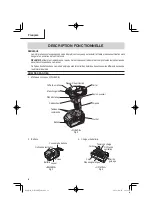
Examples of tightening mode selector function settings
Soft mode
Normal mode
Power mode
Self drilling screw mode
Rotation speed
0 – 900 /min
0 – 2900 /min
Use
“Delicate work”
Tightening small
diameter screws
(M6 or similar), etc.
“Normal work”
Tightening short
screws,
A
ffi
xing plasterboard,
etc.
“Heavy load work”
Tightening long
screws, coach screws,
bolts, etc.
Self drilling screw
tightening
10. Tightening and loosening screws
Install the bit that matches the screw, line up the bit in
the grooves of the head of the screw, then tighten it.
Push the impact driver just enough to keep the bit
fi
tting the head of the screw.
CAUTION
●
Applying the impact driver for too long tightens
the screw too much and can break it.
●
Tightening a screw with the impact driver at an
angle to that screw can damage the head of the
screw and the proper force will not be transmitted
to the screw. Tighten with this impact driver lined
up straight with the screw.
11. Tightening and loosening bolts
A hex. socket matching the bolt or nut must
fi
rst be
selected. Then mount the socket on the anvil, and grip
the nut to be tightened with the hex. socket. Holding
the tool in line with the bolt, press the power switch to
impact the nut for several seconds.
If the nut is only loosely
fi
tted to the bolt, the bolt
may turn with the nut, therefore mistaking proper
tightening. In this case, stop impact on the nut and
hold the bolt head with a wrench before restarting
impact, or manually tighten the bolt and nut to prevent
them slipping.
OPERATIONAL CAUTIONS
1. Resting the unit after continuous work
After use for continuous bolt-tightening work, rest the
unit for 15 minutes or so when replacing the battery.
The temperature of the motor, switch, etc., will rise
if the work is started again immediately after battery
replacement, eventually resulting in burnout.
CAUTION
Do not touch the metal parts, as it gets very hot
during continuous work.
2. Cautions on use of the speed control switch
This switch has a built-in, electronic circuit which
steplessly varies the rotation speed. Consequently,
when the switch trigger is pulled only slightly (low
speed rotation) and the motor is stopped while
continuously driving in screws, the components of
the electronic circuit parts may overheat and be
damaged.
3. Use a tightening time suitable for the screw
The appropriate torque for a screw di
ff
ers according
to the material and size of the screw, and the material
being screwed etc., so please use a tightening time
suitable for the screw. In particular, if a long tightening
time is used in the case of screws smaller than 5/16"
(M8), there is a danger of the screw breaking, so
please con
fi
rm the tightening time and the tightening
torque beforehand.
4. Work at a tightening torque suitable for the bolt under
impact
The optimum tightening torque for nuts or bolts
di
ff
ers with material and size of the nuts or bolts. An
excessively large tightening torque for a small bolt
may stretch or break the bolt. The tightening torque
increases in proportion to the operation time. Use the
correct operating time for the bolt.
5. Holding the tool
Hold the tool
fi
rmly with both hands. In this case hold
the tool in line with the screw or bolt.
It is not necessary to push the tool very hard. Hold the
tool with a force just su
ffi
cient to counteract the impact
force.
6. Con
fi
rm the tightening torque
The following factors contribute to a reduction of the
tightening torque. So con
fi
rm the actual tightening
torque needed by screwing up some bolts before the
job with a hand torque wrench. Factors a
ff
ecting the
tightening torque are as follows.
(1) Voltage
When the discharge margin is reached, voltage
decreases and tightening torque is lowered.
17
English
000Book̲WH36DB̲USA.indb 17
000Book̲WH36DB̲USA.indb 17
2018/09/27 18:36:11
2018/09/27 18:36:11






























